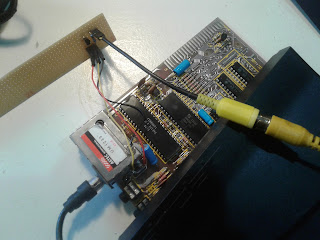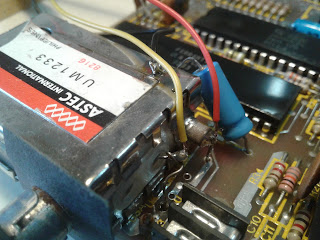A table of the Sinclair ZX81's character set and codes is a essential tool for the ZX81 developer.
DEC. HEX. Character / [Description]
0 0x00 [SPACE]
1 0x01 [plot, top left]
2 0x02 [plot, top right]
3 0x03 [plot, top (both)]
4 0x04 [plot, bottom left]
5 0x05 [plot, left (both)]
6 0x06 [plot, bottom left and top right]
7 0x07 [plot, left (both) and top right]
8 0x08 [checkered]
9 0x09 [checkered, bottom]
10 0x0a [checkered, top]
11 0x0b "
12 0x0c £
13 0x0d $
14 0x0e :
15 0x0f ?
16 0x10 (
17 0x11 )
18 0x12 >
19 0x13 <
20 0x14 =
21 0x15 +
22 0x16 -
23 0x17 *
24 0x18 /
25 0x19 ;
26 0x1a ,
27 0x1b .
28 0x1c 0
29 0x1d 1
30 0x1e 2
31 0x1f 3
32 0x20 4
...
37 0x25 9
38 0x26 A
39 0x27 B
40 0x28 C
41 0x29 D
42 0x2a E
43 0x2b F
44 0x2c G
45 0x2d H
46 0x2e I
47 0x2f J
48 0x30 K
49 0x31 L
50 0x32 M
51 0x33 N
52 0x34 O
53 0x35 P
54 0x36 Q
55 0x37 R
56 0x38 S
57 0x39 T
58 0x3a U
59 0x3b V
60 0x3c W
61 0x3d X
62 0x3e Y
63 0x3f Z
64 0x40 RND
65 0x41 INKEY$
66 0x42 PI
67 0x43 to
111 0x6f non-printable/unused
112 0x70 UP
113 0x71 DOWN
114 0x72 LEFT
115 0x73 RIGHT
116 0x74 GRAPHICS
117 0x75 EDIT
118 0x76 NEWLINE
119 0x77 RUBOUT
120 0x78 K/L MODE
121 0x79 FUNCTION
122 0x7a to
125 0x7d non-printable/unused
126 0x7e NUMBER
127 0x7f CURSOR
128 0x80 to
191 0xbf inverse of 0x00 to 0x3f
192 0xc0 "" [double-quotes]
193 0xc1 AT
194 0xc2 TAB
195 0xc3 non-printable/unused
196 0xc4 CODE
197 0xc5 VAL
198 0xc6 LEN
199 0xc7 SIN
200 0xc8 COS
201 0xc9 TAN
202 0xca ASN
203 0xcb ACS
204 0xcc ATN
205 0xcd LN
206 0xce EXP
207 0xcf INT
208 0xd0 SQR
209 0xd1 SGN
210 0xd2 ABS
211 0xd3 PEEK
212 0xd4 USR
213 0xd5 STR$
214 0xd6 CHR$
215 0xd7 NOT
216 0xd8 ** (double asterisk)
217 0xd9 OR
218 0xda AND
219 0xdb <=
220 0xdc >=
221 0xdd <>
222 0xde THEN
223 0xdf TO
224 0xe0 STEP
225 0xe1 LPRINT
226 0xe2 LLIST
227 0xe3 STOP
228 0xe4 SLOW
229 0xe5 FAST
230 0xe6 NEW
231 0xe7 SCROLL
232 0xe8 CONT
233 0xe9 DIM
234 0xea REM
235 0xeb FOR
236 0xec GOTO
237 0xed GOSUB
238 0xee INPUT
239 0xef LOAD
240 0xf0 LIST
241 0xf1 LET
242 0xf2 PAUSE
243 0xf3 NEXT
244 0xf4 POKE
245 0xf5 PRINT
246 0xf6 PLOT
247 0xf7 RUN
248 0xf8 SAVE
249 0xf9 RAND
250 0xfa IF
251 0xfb CLS
252 0xfc UNPLOT
253 0xfd CLEAR
254 0xfe RETURN
255 0xff COPY










